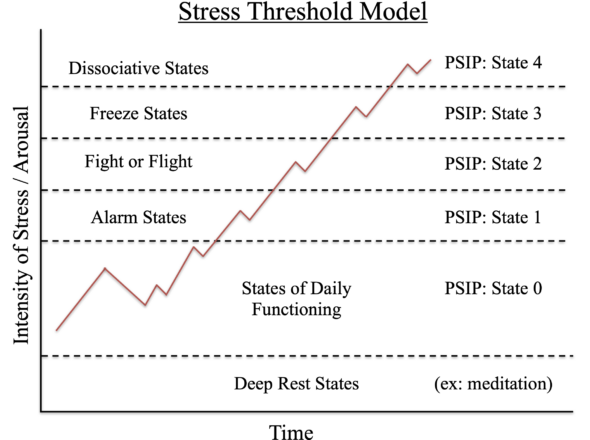Psychedelic Somatic Interactional Psychotherapy (PSIP)
What is PSIP?
Psychedelic Somatic Interactional Psychotherapy (PSIP) is a unique style of trauma therapy that is particularly powerful in resolving early childhood trauma and dissociative trauma. Unlike standard ketamine assisted psychotherapy (KAP), which uses a high (psychedelic) dose of ketamine and works in non-ordinary states of consciousness, PSIP uses a low (psycholytic) dose of ketamine and/or a low dose of cannabis. These lower doses allow clients to stay focused on the physical manifestations of their trauma as they appear in their body or primary consciousness.
Read more about psychedelic dose therapy (KAP)
Primary consciousness can be thought of as the mammalian-body consciousness that we are all born with before we start to see the world through the lens of interpretive thinking. It is an embodied form of consciousness that continues to operate underneath our “ordinary” cognitive secondary consciousness. Non-ordinary consciousness is what emerges when we enter into an altered state of reality. It can include an expansive sense of self, ego disillusionment, transpersonal states and out of body experiences.
Read more about primary consciousness
Psychedelic Somatic Interactional Psychotherapy (PSIP): How is it different?
Resources and Management Skills
Many psychotherapies work within the realm of ordinary consciousness, or ego consciousness, in which the client’s difficulties are addressed verbally, cognitively, and behaviorally. This type of cognitive behavioral therapy is useful in gaining insights, developing alternative perspectives, and learning effective coping strategies. Unfortunately, it often falls short when it comes to healing trauma because “the charge” of a traumatic wound exists as a body memory in one’s primary consciousness. So while trauma does affect the way we think and behave, especially when we get triggered, the charge itself does not reside in our cognitive processes. Thus, while talk therapy can teach us to cope with the symptoms of trauma, healing trauma needs to happen through the body.
Body-Based Somatic Trauma Therapy
PSIP is similar to other body-based trauma therapies such as Brainspotting, Somatic Experiencing, EMDR, and Sensorimotor Psychotherapy, in that it focuses on processing subconscious body sensations and movement patterns. What makes PSIP so powerful is that it utilizes the effects of THC (from cannabis) and ketamine to increase body awareness, soften defenses, and increase tolerance to fear and other intense emotions. This allows clients to work directly with intense and/or dissociative symptoms. In doing so, clients are able to connect with, tolerate, and rapidly process deep traumatic memories that would otherwise be too buried, too dissociated, or too intense to work with. (Most trauma therapies actively avoid this.)
Psychedelic Somatic Interactional Psychotherapy (PSIP) and the Therapeutic Relationship: The Importance of Interpersonal Connection When Working with Trauma.
Many traumatic events involve a direct relational dynamic with another person, for example, abuse, assault, toxic shaming, and neglect). Other types of traumatic events, for example accidents and illnesses, may not be caused by someone else, but the event still involves the presence or absence of a “helpful” other. In either case, relationship is a key component to the experience of, and the healing of, trauma.
According to Stephen Porges, as mammals, our first line of defense against traumatic stress is social engagement. This “hard wiring” of the mammalian brain to utilize the presence of a caring attuned safe other is witnessed in almost every therapeutic modality. In Porges’ theory, if social engagement fails, a mammal will then shift to fight or flight, then freeze, then dissociate.
Additionally, Diana Fosha (founder of AEDP) claims that childhood wounding is not caused by painful experiences themselves. She proposes that when a painful event is met with punishment, humiliation, or neglect (as opposed to an empathetic safe attuned other) that the child is left in a state of existential aloneness. It is this aloneness with the pain that leads to psychological wounding. While Diana is primarily focused on attachment wounding, the importance of a safe attuned other is just as important when working with trauma. PSIP, therefore, actively utilizes the client-therapist connection as a key component of the modality.
Psychedelic Somatic Interactional Psychotherapy (PSIP), the Stress Threshold Model, and Moving through Waves of Activation
As mammals, we are biologically designed to experience five stages of arousal. Arousal refers to the level of activation that the autonomic nervous system generates when faced with the presence of a stressful or threatening environment. In our ordinary day to day lives, we live within a baseline range of activation that fluctuates depending on how active or restful we are in any given moment. This range of activation is influenced by the amount of stress in our lives, but it can also be elevated if we carry a lot of traumatic charge in our primary consciousness.
State 0
In the PSIP model, the least activated state is referred to as State 0. It is a state in which one feels relaxed and alert. This state is often accompanied by feelings of ease, neutrality, and wakefulness.
State 1
As stress increases, or threat emerges, we move into an “hyper alert” state or State 1. This state in and of itself is not problematic. If you have ever gone to see a scary movie or ridden a roller coaster, then you have paid money to be put into this heightened state of arousal. The state becomes problematic, however, if it is chronic or if the body is unable to return to state 0, for living in a state of chronic arousal is bio-chemically difficult on the body and emotionally difficult on the psyche.

State 2
Most people would likely recognize State 2 as the fight or flight response. It is a state of high arousal, intense fear, or panic, and can include anger. In this state the body is attempting to mobilize itself with a lot of energy in an attempt to overcome or escape threat. (Please be aware that the threat can be physical, emotional, or psychological in nature.)
State 3
If the fight or flight response fails, our nervous systems are designed to protect us through two State 3 responses. The most commonly known is the Freeze response. It is characterized by experiences of collapse, lethargy, sleepiness, feeling heavy or cold, slow motor movement or speech, feeling helpless or hopeless, confusion, visual distortion, and immobilization.
The other State 3 response is the Fawn response in which the person unconsciously makes themself small, innocent or helpless, and tries to “please” as a means of avoiding harm.
State 4
The final state of activation is dissociation. It is characterized by numbness, depersonalization, hollow or empty sensations, feeling emotionally flat, feeling floaty or spacey, or having an out of body experience. One interesting aspect of this state is that someone can also experience a sense of cognitive clarity and calm while being dissociated. This can make it feel confusing to know which state (0 or 4) one is in.
PSIP Traumatic Memory: How it is stored. How it is healed.
When a stressful or threatening situation happens too fast, too intensely, or for too long, and the body becomes overwhelmed and flooded by the experience, the body is designed to cut off from the experience, including numbing itself from the internal unbearable sensations caused by the event. In doing so, the internal “state of terror” or distress becomes compartmentalized in our implicit memory system. The implicit memory system is where our body-based (primary consciousness) experiences are stored. These memories can include any or all of the state 1 through state 4 experiences.
Remember, this compartmentalized body-based memory is where we carry the “charge” of our trauma. It is the source of our “triggers”, it can lead to a high baseline anxiety or chronic state of dissociation, and it can even cause physical ailments and chronic health conditions.
In PSIP, we work with the medicines, body awareness and relational support to create the conditions that allow someone to re-associate to implicit memory in which the charge of the trauma is held. From there, we can work through the state of activation, clearing the memory of the charge, and returning the body to State 0.
What does the process look like?
Step One: Free Phone Consultation
PSIP, like ketamine-assisted psychotherapy (KAP), begins with a free phone consultation. We will discuss what your experience of trauma was and how PSIP can help. Additionally, the phone call is a chance for you to get a feel for who I am. Working with trauma requires us to make ourselves vulnerable, so it’s important to ensure that you feel comfortable with me.
Step Two: Medical Intake
Ketamine is a (FDA) Schedule III medication and therefore you will need to get a prescription from a medical physician. I can provide you with medical providers that specialize in assessing the safety and appropriateness of ketamine therapy. If approved, the medical provider will send your prescription to their pharmacy. Usually, the pharmacy will then mail the ketamine directly to you. You would then bring the ketamine to session and self-administer the medication according to your doctor’s instructions.
In regards to cannabis, due to scope of practice, I cannot recommend any particular strain of cannabis. I can only inform you that it is the TCH not the CBD that allows us to work on dissociation. As far as being able to connect more deeply to body sensations, dispensaries will often educate you on the choices that you can explore. Most people either smoke or vape at the time of the session. Some people also choose to ingest cannabis prior to the session.
Safety reminder: Do not drive under the influence of either medication. Please arrange transportation ahead of time.
Step Three: Preparatory Sessions
Once you have been approved to use ketamine by a licensed medical provider, we will need to do an intake session so that I have more information about your trauma history. We will then need to do “resourcing sessions” so that you have the external and internal support that you will need to take care of yourself between sessions. The number of resourcing sessions will depend on how much support you already have in your life. Once you feel you have the support you need, we will then do a non-medicine session so that you can learn the skills needed to navigate working in primary (body) consciousness. After that, we will start introducing the medicine into our work together.
A resource can be any person, place, object, or activity that a person can use to deal with the stress and anxiety of their day.
Step Four: Ketamine Therapy Sessions
PSIP sessions are two hours long. The sessions begin by checking in about any new experience or concerns that emerged between sessions. Next, you would self-administer the medication(s). Which medications and how much medication you take is something you can adjust from session to session as needed. If you use ketamine, the psycholytic dose will be at the bottom range of what your medical provider prescribed. While psycholytic doses don’t have the “peak experience” of a psychedelic dose, you will still notice an altered state of consciousness for 45 to 60 minutes.
As the medicine wears off, clients often describe the transition as feeling like their “cognitive brain” is coming back on-line. When this shift occurs, I will guide you to stay in your process. Often when one’s cognition comes back on-line, there is still an opportunity to do deep talk therapy while the brain is still experiencing the neuroplasticity of the medicine. [Link] Towards the end of the session, you may also want to work on integrating particular aspects of your experience.
Step Five: Integration
At any point in our work together you can request an integration session if it feels like you need some time to process what has been coming up during the medicine session.
